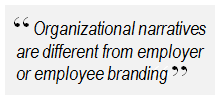
Organizational narratives are the manifestation of the shared beliefs an organization holds about itself as a collective. “Our organization stands for innovation,” is a common example; “This will never work here, we are too conservative for that” yet another. Corporate narratives that deal with the collective view the organization holds about itself often form and coalesce around past and current successes or failures.
Ultimately, they define what the organization is all about and how it is seen by outsiders and insiders. The more consistent they are being told, the more they dominate the dynamics of organizational life. As such, understanding your organizational narratives is a dynamic way of understanding the current state of your company.
Narratives of Organizational Self
The organizational stories of “self” shape the organizational climate as much as they influence directives, decision-making processes and overall strategies. Organizational narratives are different from employer or employee branding. While branding is a deliberate effort, narratives are born in the moment and reflect the collective fears, hopes and aspirations. As these narratives are based on what large groups perceive as reality, they go viral seemingly effortlessly: from the CEO to the entire staff and back, across suppliers and customers to the outside world.
 Eventually they can even influence the opinion the public holds about the organization. Studies show that when organizational self-stories match the practical reality a company faces, these narratives can help foster motivation and grounded decision making; if they start diverging from the practical reality, however, they can result in inertia or nostalgia.
Eventually they can even influence the opinion the public holds about the organization. Studies show that when organizational self-stories match the practical reality a company faces, these narratives can help foster motivation and grounded decision making; if they start diverging from the practical reality, however, they can result in inertia or nostalgia.
Corporate narratives can take many shapes and forms. An interesting starting point for an analysis may be to look at self-narratives that deal with the past. Here, three primary categories can be distinguished: narratives that aim to preserve the past, narratives that defy the past, and narratives that refrain from taking a stand regarding the past, but instead create a curiosity to move forward and explore what the future might hold.
Preservative narratives
Preservative narratives deal with the past as if it was a frozen relict: they excessively remember past charismatic leaders or the way things were; they glorify the perceived values the organization stood for back then. Should the stories in our organizations predominantly preserve what the organization may or may not have been or done in the past, the organization may begin to resemble a large museum filled with historic statues and artifacts. “Nice to look at,” one might say, but how much do those statues still have to do with our current reality? While the past may be important to remember, we always have to ask ourselves whether its magnified projection enables or hinders the members of the current organization to make history themselves.
Defying organizational narratives
Defying organizational narratives strive to overcome the past, and often the present, along with it. Suddenly, everything the organization stands for is considered outdated and has to be renewed. “Five years ago, we missed this important trend that is now dominating the market. Now it is practically too late.” This type of collective self-talk can turn into a dangerous spiral or self-fulfilling prophecy. This kind of narrative does not keep anything from the past alive; instead it attempts to destroy all statues in that previously mentioned museum.
Goethe said, “I despise everything which merely instructs me without increasing or immediately enlivening my activity.” Both preservative and defying organizational narratives can feel instructive in that respect. Both come with a mission to either glorify the past or to eliminate everything from it. Both types of narratives have a tendency to stifle attempts to create new ways of thinking and doing.
Enlivening organizational narratives
Enlivening narratives have a different focus. They inspire the organization and its people to “increase and enliven action.” “If not now, when? If not us, who?” might be a famous example of a narrative that motivates people to rise to the occasion and to create a common future. Despite their positive nature, enlivening narratives are often born during difficult times. Much like challenges can motivate healthy action, difficult times can spark enlivening narratives.
Generally, an organization thrives on a healthy balance of all three narrative types. Once a consistent narrative forms, it is often difficult to change it. Knowing which kinds of narratives shape your organization may provide a powerful platform for future change.
Helpful questions could be:
- Do the narratives we tell ourselves still match the organizational reality? Are we still doing as well as we tell each other? Are we really doing as badly as we hear people lament?
- Do our narratives stimulate a desire to actively shape the present and the future of our organization?
- Are we able to switch narratives or are we stuck in one? Can we think in one paradigm when needed, as opposed to another?
- Do our narratives help us understand the pros and cons of the current situation well enough to pro-actively move into a more productive future?
By guest author Erika Jacobi, CEO and Head Consultant of LC GLOBAL Consulting Inc. (www.lc-global-us.com) Erika specializes in Organizational Psychology and Large Scale Organizational Change. She has coached and consulted to leaders of international organizations in the U.S., Europe and the Middle East – amongst them numerous Fortune 100. Erika’s current PhD research focuses on the Role of Narratives in Organizational Change.











